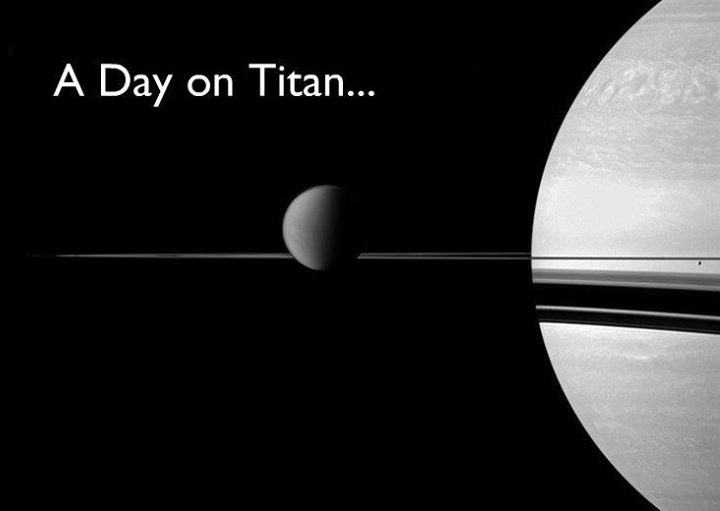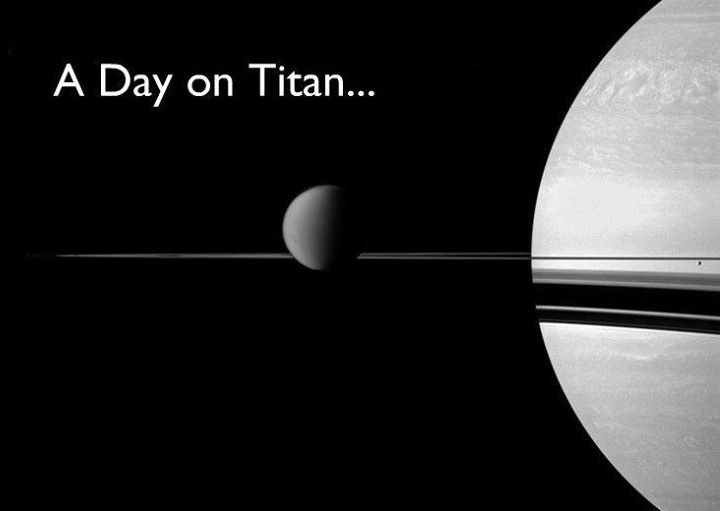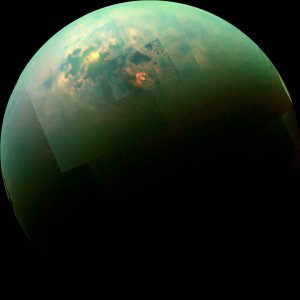

Today, I want to talk about what it would be like to spend a day on Titan (one of Saturn’s moons).
I hardly need to try and convince you that Titan is worth visiting; the facts make a more persuasive argument than I ever could. Titan is the largest of the 53 moons that orbit Saturn; in fact, it is the second largest moon in our solar system (only Jupiter’s Ganymede surpasses it). This means that Titan is much bigger than our own Moon and, ultimately, even the planet Mercury. But despite being one of the most sizable moons in our solar system, Titan has a rather weak gravitational pull (a person who weighs 100 pounds on Earth will only weigh 12 pounds on Titan. i.e. Titan is a great place for jumping and, thus, basketball).
But I’m afraid that this interesting moon is rather inhospitable.
Titan’s average surface temperature is a chilly -289 degrees Fahrenheit (-178 degrees Celsius), which is a little cold even for the hardiest Earthlings (extremophiles included). For example, frostbite occurs when your body fluids freeze in your skin, and the frostbite danger zone begins at just about 32ºF (0ºC). Which means that the temperatures on this tiny moon will freeze you solid almost instantaneously. Yet, you shouldn’t let the temperature keep you from visiting this magnificent rock, because Titan is the only moon in the solar system known to have clouds and a thick planet-like atmosphere.
Like Earth, Titan’s cloudy atmosphere is mostly nitrogen, but it seems to contain much higher percentages of “smoggy” chemicals (like ethane). This smog gathers into such large concentrations that it rains “gasoline-like” liquids (something that denizens of L.A might be familiar with).
Of course, a moon that has gasoline-like rain sounds like a huge candle (bomb?) that is just waiting to be lit. Hardly sounds like a good place to visit. However, combustion requires oxygen, so as long as they’re super careful with your oxygen tanks (emphasis on the “super”), any manned missions to Titan will be fine.
Yet, on the off chance that there is a fire, we wouldn’t want to try and put it out with water. Why? I’ll give you a hint: in H2O the “O” stands for “oxygen.”
And it seems that there might be quite a lot of this gasoline-like rain on Titan. Radar images from the Cassini spacecraft revealed a land of lakes in Titan’s northern hemisphere; these lakes are about the size of North America’s Great Lakes.

This liquid lake seems to be mostly methane (which changes from a gas to a liquid at -117F/ -83C), and it moves about quite a bit, as Cassini also detected canyon-like structures on the surface of the moon.
Swimming or boating on these lakes will be difficult, as the density of liquid methane is only about half the density of water. As a result, paddlers will have a hard time churning the methane enough to propel the craft (or their bodies) when needed.
And obviously, you’ll need special spacesuit-like swimming gear…or have a body that is made of material that is resistant to cracking at cryogenic temperatures (frankly, I think you should work on making the latter a reality).
That said, it has also been imagined that this slightly less dense fluid, coupled with Titan’s much lower gravity, will enable you to push yourself about half way out of the water, kind of like a dolphin.
Best of all? The air is much denser here. Titan’s atmospheric pressure is about 60 percent greater than the Earth’s, so walking on Titan will be roughly the same as walking on the bottom of a swimming pool. Since you are lighter and the air is denser, with large artificial wings, it might be possible to take off and fly.
Frankly, I think the ability to fly is worth hazarding methane lakes and freezing temperatures. Sign me up for the first colony.
From Quarks to Quasars is two people, Jaime and Jolene. We want to make the world a more sciencey place. We’re doing that, but with your help, we can do even more.
FQTQ takes a lot of time, money, and effort. Here, you can support us, get to know us, and access extra content: